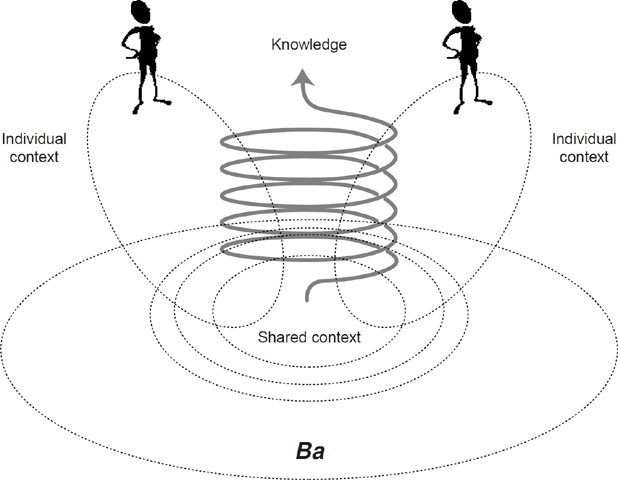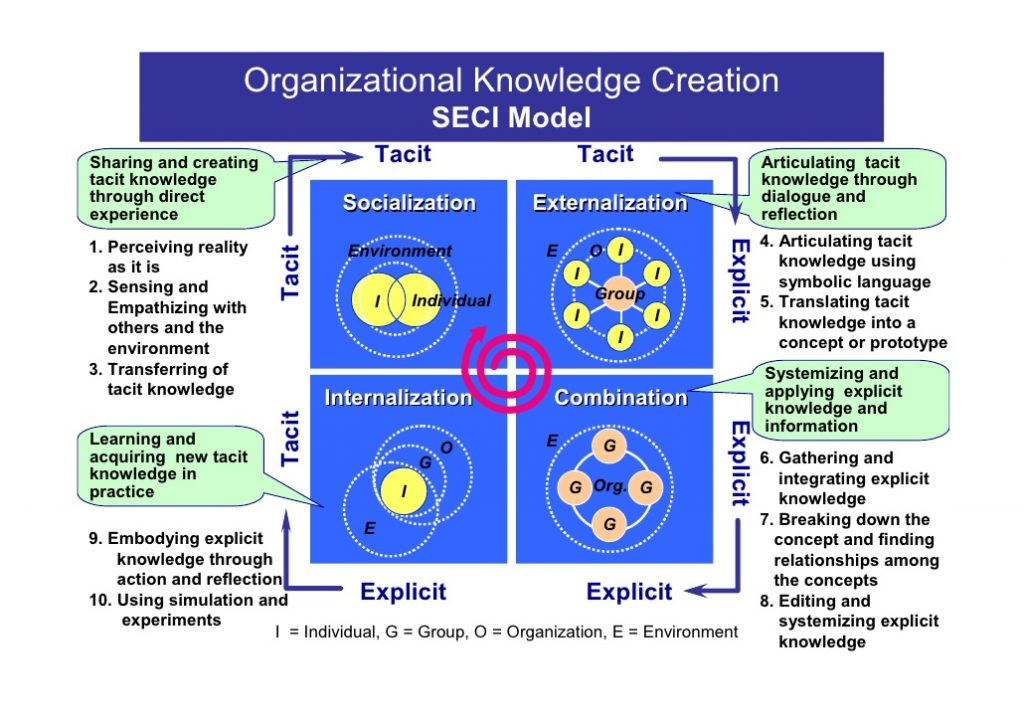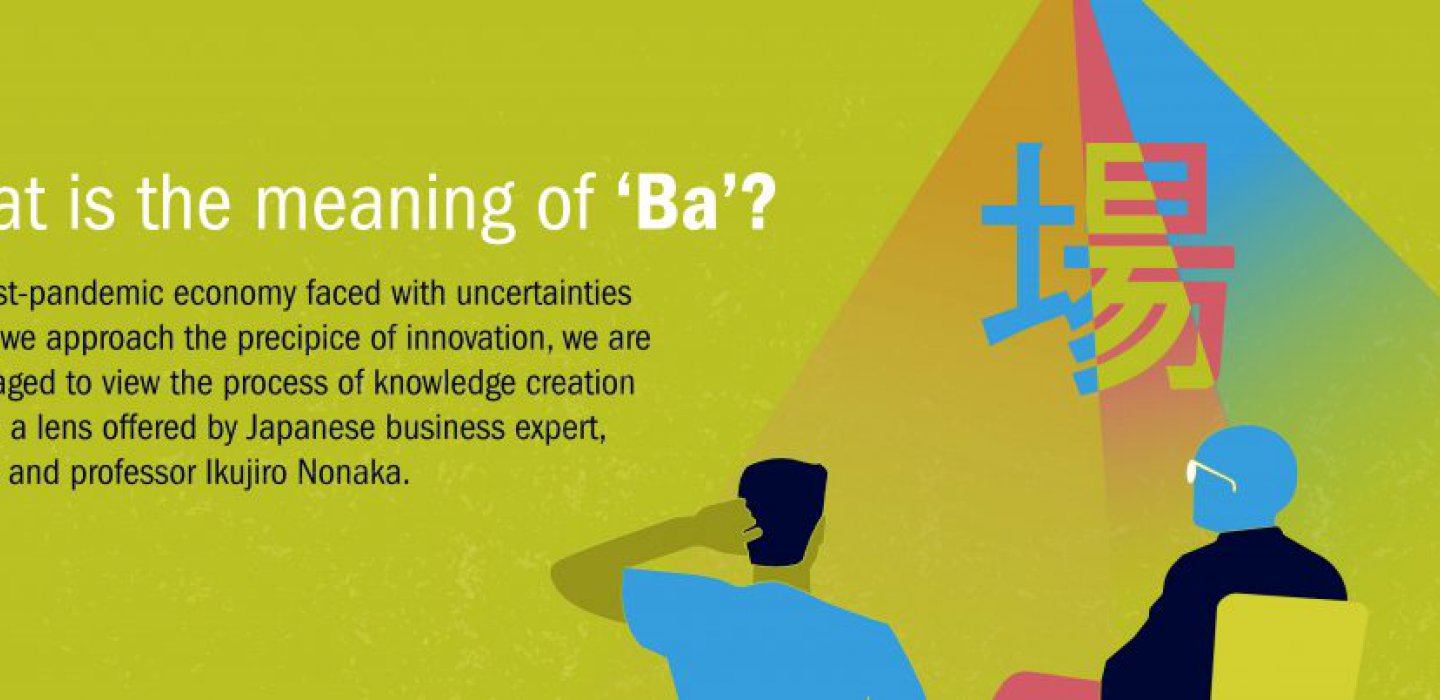Where is ‘Ba’?
The more valid question would be: What is ‘Ba’? For those unfamiliar with the novel concept of ‘Ba’, an in-depth examination will uncover a valuable context serving as a foundation for advancing knowledge creation. In a post-pandemic economy faced with uncertainties and as we approach the precipice of innovation, we are encouraged to view the process of knowledge creation through a lens offered by Japanese business expert, theorist and professor Ikujiro Nonaka.
The Japanese word ‘Ba’ roughly translates into the English word “space” or “place”. Inspired by the work of the most influential existentialist Japanese philosopher of the 20th century Kitaro Nishida, and further developed by Shimizu (1995), Nonaka and Konno adopted and brought forward the concept of ‘Ba’ in 1998 for the purpose of elaborating the model of knowledge creation.

They described ‘Ba’ as a shared space for emerging relationships, a space used as the foundation for the creation of individual and collective knowledge; an intermediary platform where the ‘self’ is recognized in the ‘all’, where one’s limited perspective or boundary is transcended. ‘Ba’ harbours meaning and value, integrating the collected knowledge, thus creating a learning and relearning ecosystem.
But what does ’Ba’ have to do with knowledge creation?
Would you agree with us in discerning that successful organizations are ‘learning organizations’? Leaders and change management gurus promise change which largely remains cosmetic in nature. What gives Sharp, Toshiba and Maekawa Seisakusho an edge in organizational design that assures continuous transformation?(1)
“The ability of an organization to create new knowledge is essential to its innovation capability”. Nonaka, Toyama et al. [2000] go further stating that “The raison d’etre of a firm is to continuously create knowledge.”
Knowledge needs a context to be created since “there’s no creation without place” and that place is ‘Ba’:
“[…] in knowledge creation, generation and regeneration of ‘Ba’ is the key, as ‘Ba’ provides the energy, quality and place to perform the individual conversions and to move along the knowledge spiral. […] knowledge is created through the interactions amongst individuals or between individuals and their environments. […] ‘Ba’ is the context shared by those who participate in ‘Ba’. […] ‘Ba’ is the place where information is interpreted to become knowledge.” (Nonaka et al., 2000)
We perceive ‘Ba’ as a potent constituent of knowledge creation. Our team is modelled around this concept, and we thrive on working through metaphor to model, chaos to change and research to innovation.
“What I have learned and continue to learn from Nonaka is that knowledge needs nurturing. My job is to continually cultivate the capability of our people in order to respond to current and future challenges.”
– Dr. Ginger Grant, Ph.D., Dean of Humber Research & Innovation
Nonaka further explains that ‘Ba’ represents a contextual place in motion shared with others from which relationships emerge and within which knowledge is exchanged, nurtured and used. This place may be physical, virtual, mental or a combination of these. Knowledge is embedded in ‘Ba’. According to the theory of existentialism, in this self-transcendental place, where one’s limited perspective of knowledge is merged with the whole, the ‘Ba’ for individuals is the group (team), the ‘Ba’ for groups is the organization, and the ‘Ba’ for organizations is the market environment.; and this creative process of knowledge creation is amplified when all these ‘Ba’ conjoin to form a ‘basho’.
Nonaka: “To function in ‘Ba’, one must have the ability to empathize; to put oneself in the position of the other and understand their feelings so that one can see oneself in relation to others and accept others’ views and values.”
A Self-Transcendental Process
That beckons us to clarify the meaning of ‘knowledge creation’ itself in this context. The term ‘knowledge’ that academic institutions and corporations often refer to just means ‘information’. Nonaka’s model of organizational knowledge is described as “the capability of a company as a whole to create new knowledge, disseminate it throughout the organization, and embody it in products, services, and system” (Nonaka & Takeuchi, 1995).
To address the fundamental nature of knowledge creation, Nonaka and Konno (1998) started the discussion about the concept of ‘Ba’ by presenting the question: “Is it possible to actually manage knowledge like other resources?”
According to Nonaka, knowledge creation is a spiralling process of interactions between two kinds of knowledge: explicit (codified knowledge, expressed through language or digital means, readily transmitted between individuals), and tacit or implicit (personal and hard to articulate knowledge, spanning technical know-how and cognitive dimensions like personal insights, intuitions, insights, ideals, values or emotions). ‘Ba’ is the context for this knowledge creation. The combination of the two makes it possible to conceptualize four knowledge conversion patterns in the form of the SECI framework, which assumes that organizations are knowledge-creating entities, not merely information processing ones. We argue that, in general, in the west explicit knowledge has been emphasized, and much lower value, or even awareness, has been placed on tacit knowledge.
Nonaka adapted Nishida’s theories, especially the Ontology of Consciousness, Theory of Universals and Logic of Space, to elaborate the SECI model of knowledge creation (invented by Nonaka in 1994), a well-known and well-used model in management theory and practice.

The SECI Model
In ‘The Knowledge-Creating Company’ (Nonaka &Takeuchi, 1995), Nonaka stresses that the spiralling interaction between tacit and explicit knowledge, which leads to new knowledge, is performed by individuals, not by organizations. An organization is not a machine but a living organism. Nonaka also contends that this model can only work most successfully when supported by an organizational structure which consciously fosters each of the knowledge conversion modes.
The spiral of organizational knowledge creation occurs in a series of four knowledge conversion modes. Alongside, there are four types of ‘Ba’ that correspond to the four stages of the SECI model.

Socialization: Tacit-to-Tacit: Empathizing: Face-to-Face
Sharing, capturing and disseminating personal experiences and knowledge through physical proximity. Empathize rather than sympathize. Self-transcendence is fundamental to sharing individual tacit knowledge. Capturing knowledge by walking around inside the company to observe and interact through dialogue. Create a common place – or ‘Ba’
Externalization: Tacit-to-Explicit: Articulating: Peer-to-Peer
Articulating knowledge into comprehensible forms that others can understand, e.g., use of metaphors, analogies or narratives, visuals, words and images. An individual transcends the self and commits to the group, thus becoming one with the group. The sum of the individuals’ intentions and ideas fuse and become integrated with the group’s mental world.
Combination: Explicit-to-Explicit: Connecting: Group-to-Group
Conversion of explicit knowledge into more complex sets of explicit knowledge. The combination phase relies on capturing and integrating new explicit knowledge, dissemination based on transferring this form of knowledge directly by using presentations or meetings, and editing or processing explicit knowledge making it more usable, e.g., plans reports, market data.
Internalization: Explicit-to-Tacit: Embodying: On-the-Site
The internalization of newly created knowledge is the conversion of explicit knowledge into the organization’s tacit knowledge. This requires the individual to identify the knowledge relevant for one’s self within the organizational knowledge. That again requires finding one’s self in a larger entity. Think training programs and triggering learning-by-doing processes.
“[…] Organizational Knowledge Creation is defined as the process of making available and amplifying knowledge created by individuals as well as crystallizing and connecting it to an organization’s knowledge system. […] (Nonaka et al. 2006).
The ‘Ba’ Effect
There are four types of ‘Ba’ proposed by Professor Ikujiro Nonaka that correspond to the four stages of the SECI model. Each category describes a ‘Ba’ especially suited to each of the four knowledge conversion modes; thereby each ‘Ba’ speeds up the process of knowledge creation.
Originating ‘Ba’ – Socialization | Empathize
Nonaka emphasizes that physical contact is vital in originating ‘Ba’ to facilitate knowledge creation. It is the beginning of the knowledge creation process in the SECI model. Face-to-face interactions. From originating ‘ba’ emerge care, love, trust and commitment. In a post-pandemic environment, platforms like Zoom, Teams and the likes fill in as substitutes.
Dialoguing ‘Ba’ – Externalization | Articulate
It is consciously constructed. Selecting people with the right mix of specific knowledge and capabilities for a project team is critical. This is the place where tacit knowledge is made explicit. Dialogue is key for such conversions, and the extensive use of metaphors is one of the conversion skills required. The possibility of novices bringing up a new thought is supported.
Systemizing ‘Ba’ – Combination | Collaborate
It is a place of interaction in a virtual world instead of real space and time. The combining of new explicit knowledge with existing information and knowledge generates explicit knowledge throughout the organization. The use of online networks, groupware, documentation, and databanks supports and helps expand knowledge.
Exercising ‘Ba’ – Internalization | Embody
Rather than teaching based on analysis, learning by continuous self-refinement through on-the-job training or active participation is emphasized. Thus, the internalization of knowledge is continuously enhanced by the use of explicit knowledge in real life or simulated applications. It is more of a learning process in each individual as it allows the conversion of explicit to tacit knowledge. Feedback and self-assessments support this step.
“[…] Knowledge originates in ‘Ba’, and therefore the concept of ‘Ba’ assumes a particular importance in organizational knowledge creation theory. While ‘Ba’ is theoretically relevant, it is also empirically under-explored.” (Nonaka et al., 2006).
Are you ready to meet at ‘Ba’?
Can this concept of ‘Ba’ be applied to academic institutions? We perceive ‘Ba’ as being applicable in all scenarios that support knowledge creation. We perceive ‘Ba’ as a safe space for organizational and self-development, a space to grow together and in that space nurture knowledge creation collectively.
Equipped with this concept of knowledge creation, knowledge can perpetuate organically and support value creation. For leaders to cope with these myriad pressures, knowledge is more critical than ever before. As Nonaka aptly puts it, “the knowledge-creating process is a journey from being to becoming”.
What must leaders do to adopt this process? How do leaders create value? Why doesn’t knowledge directly result in wisdom and wise leadership? Are we missing a point of strategic importance here? The answer perhaps lies in addressing and adopting an idealistic concept of knowledge referred to as ‘practical wisdom’ or ‘distributed wisdom’; the origin lies in the philosopher Aristotle’s ‘phronesis’. Watch this space to read more on the topic of phronesis and the six abilities that phronetic leaders can embrace to pursue value creation for “common goodness”.
In the meantime, we leave you with this quote from the leading thinker and theorist Ikujiro Nonaka, Professor Emeritus at the Graduate School of International Corporate Strategy of the Hitotsubashi University, Japan:
“Wise leaders, we find, strive to understand the contradictions in human nature—good and bad, civility and incivility, optimism and pessimism, idealism and realism, diligence and laziness—and synthesize them as situations arise. Rather than seeking an optimal balance between the contradictions, or a compromise, they engage in a dynamic form of dialectical thinking. That enables them to deal with contradictions, opposites, and paradoxes by moving to a higher level. By thinking in terms of “both/and” rather than “either/or,” wise leaders can make the decision best suited to each situation without losing sight of the greater good.” – Nonaka, Ikujiro; Takeuchi, Hirotaka. The Wise Company (p. 204). Oxford University Press. Kindle Edition..
See you later at the ‘Ba’.
Image of ‘Ba’ : https://theknowledgeexplorer.files.wordpress.com/2017/07/’Ba’ _logo.jpg?w=248&h=237
- Read The Concept of “Ba”: Building a foundation for knowledge creation by Ikujiro Nonaka & Noboru Konno – Cases in the Transformation of Ba
